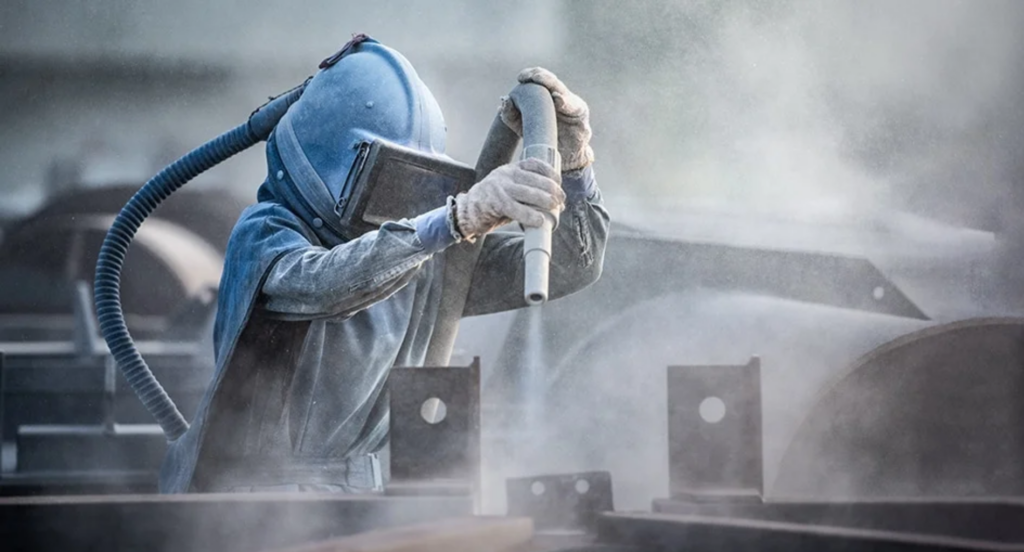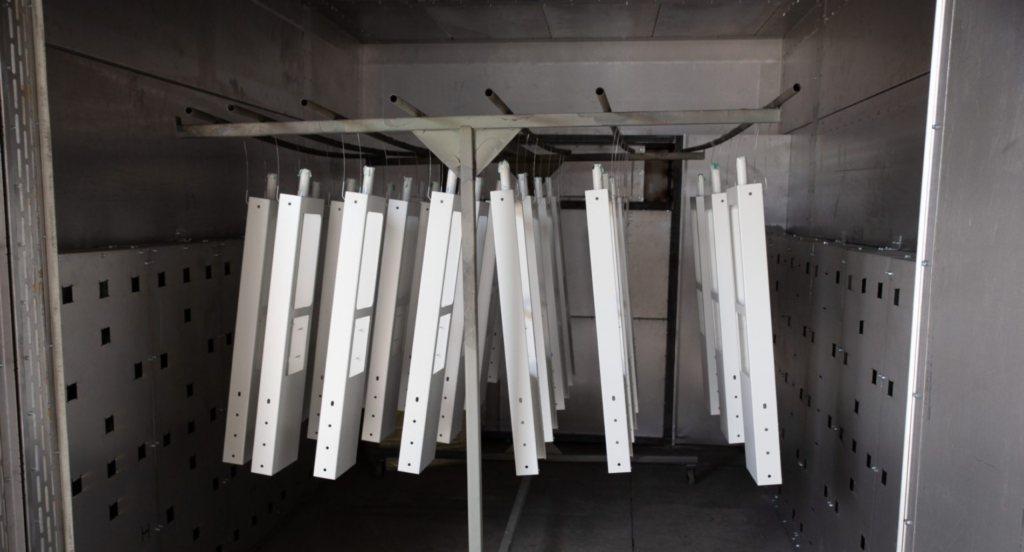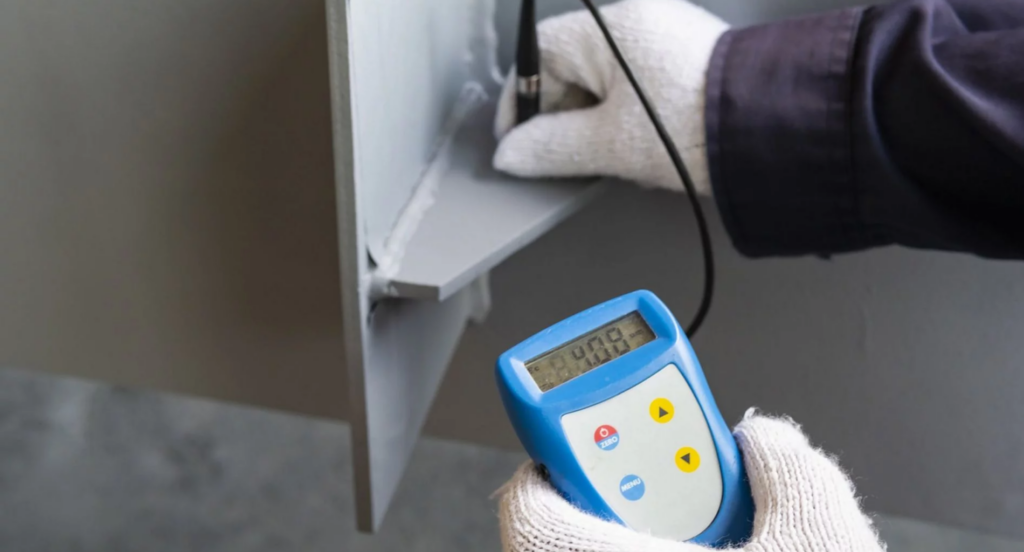Are you harnessing the full potential of the powder coating process in your operations? This advanced technique is transforming the world of surface finishing with its efficiency and versatility.
With years of industry experience and in-depth knowledge, we are uniquely equipped to guide you through the complexities of the powder coating process.
The powder coating process is a testament to innovation in surface treatment, offering a blend of durability and aesthetic appeal that stands the test of time and use.
In this guide, we will unfold the detailed journey through each critical stage of the powder coating process, providing insights to master the art of achieving flawless and durable finishes.
Read on for key insights into this efficient process.
Step#1 Preparing the Workspace
The initial step for a successful powder coating process is the effective preparation of the workspace for efficient operation and safety. Here are the essential steps to ensure the workspace is ready:
- Setting up a Clean and Safe Environment: Start by removing all unnecessary items from the workspace. Clean all surfaces to ensure they are free from dust and debris. Organize the area to create a clear and easily accessible workspace.
- Temperature and Humidity Control: Adjust the workspace temperature to the recommended range for powder coating. Use dehumidifiers to maintain the ideal humidity level. Continuously monitor and adjust these environmental conditions as needed.
- Adequate Ventilation: Install a ventilation system designed for powder coating operations. Regularly check and maintain the ventilation system to ensure it functions effectively. Adjust the system as needed to provide optimal airflow and remove harmful gases.
- Lighting and Visibility: Set up bright, uniform lighting throughout the workspace. Position lights strategically to ensure all working areas are well lit and replace any faulty lighting fixtures for consistent visibility.
Step#2 Gathering Materials and Tools Needed
Following the preparation of the workspace, the next critical phase involves assembling the necessary materials and tools for a smooth powder coating process. Here are the essential elements to gather:
- Selecting the Right Powder: Begin by choosing a suitable powder for the project. Consider factors like the type of material being coated, the desired finish, and specific environmental requirements.

- Powder Coating Gun and Attachments: Acquire a reliable powder coating gun and attachments that match the powder type and project size. Grand View Research forecasts 5.0% growth in the global powder coating equipment market from 2023-2030 due to rising demand for eco-friendly coatings.
- Safety Equipment: Gather protective gear, including masks, gloves, and safety glasses. This is essential to safeguard operators from inhaling powder particles.
- Cleaning Supplies for Surface Preparation: Organize cleaning agents and tools such as degreasers and wiping cloths. These will be used to clean and prepare the surfaces before applying the powder.
- Testing and Measurement Tools: Incorporate testing equipment to monitor the quality and consistency of the powder coating during the application process. Examples of such tools include thickness gauges and adhesion testers.
Step#3 Surface Preparation
After gathering the necessary materials and tools, the next crucial step is surface preparation. This stage ensures the base material is ready for a high-quality finish. Here are the key processes involved:
- Cleaning and Degreasing: Wipe down the surface to remove all contaminants such as loose dirt and debris. Then, apply a degreasing agent to break down and remove oily residues. Wash off the degreaser thoroughly with water, ensuring no residue remains.
- Abrasive Blasting: Set up blasting equipment and adjust the pressure to suit the material. Load the appropriate abrasive medium, such as sand or grit, into the blaster. Then, systematically direct the blasting stream over the surface to evenly remove old coatings and make a smooth texture for the new coating.

- Chemical Treatment: Apply chemical etching solutions evenly across the surface. Use brushes or sprayers for consistent application, ensuring the entire area is covered. Allow the chemical to sit for the recommended duration before rinsing it off.
- Rinsing and Drying: After chemical treatment, rinse the surface with clean water to remove any residual chemicals. Make sure the rinsing is thorough, leaving no traces of chemicals. Then, dry the surface completely, either naturally or using air blowers, to ensure it’s free from moisture.
- Inspection of Surface Integrity: Perform a thorough inspection to check for any remaining impurities or surface irregularities. Ensure the surface is uniformly prepared for the coating process.
Step#4 Applying a Pre-Treatment
Transitioning from comprehensive surface preparation, the next step focuses on pre-treatment, a crucial stage for enhancing the coating’s performance. Here are the essential processes in this phase:
- Application of Conversion Coatings: Evenly spread the conversion coating over the entire prepared surface using a spray gun or brush, ensuring full coverage without any gaps. After application, allow the coating to settle on the surface for the specified time to ensure proper adhesion.
- Use of Primers: For certain materials or environments, a primer must be applied after the conversion coating. Carefully cover the surface with a primer using a sprayer or brush to ensure a better base for the powder and add an additional layer of protection.
- Curing Pre-Treatment Layers: After application, it’s essential to cure the pre-treatment layers properly. Place the treated items in a curing oven at the recommended temperature. Keep items in the oven for the specified time to ensure a solid, adherent base for the coating.
- Quality Control Checks: Perform thorough quality control checks. Inspect the pre-treatment layers for uniformity and completeness, ensuring the surface is optimally prepared for the next step.
Step#5 Powder Application
After the pre-treatment stage, the focus shifts to the precise application of powder, a vital step for achieving a uniform and durable coating. Here are the essential actions to ensure successful powder application:
- Setting Up the Powder Coating Gun: Adjust the powder coating gun’s settings for optimal performance. Change the air pressure, flow rate, and spray pattern to suit the specific powder and item being coated.
- Applying Powder Evenly: Hold the gun at a consistent distance from the surface, moving in smooth, linear motions. Ensure each pass overlaps slightly with the previous one to avoid missed spots and achieve a uniform coat.
- Layering Techniques: Apply the first layer of powder lightly and evenly, then let it settle for a moment. For a thicker finish, add a second light layer, use techniques like cross-coating, where the second application is perpendicular to the first.
- Monitoring Application Thickness: During the powder application, regularly use a thickness gauge to check the coating’s thickness. Ensure it stays within the specified range for the type of powder and application requirements.
- Immediate Inspection for Coverage: After applying the powder, conduct an immediate inspection to check for complete and uniform coverage. Identify and fix any thin spots or missed areas before moving to the curing stage.
Step#6 Curing the Coating
Once the precise powder application is done, the curing phase is next, where the powder transforms into a strong coating. Here are the key actions to ensure a successful curing process:
- Setting the Correct Temperature: Adjust the oven temperature according to the powder type being used. This ensures the powder reaches its melting point and begins the curing process.
- Timing the Curing Process: Once the oven reaches the right temperature, place the coated items inside the preheated oven and set a timer based on the powder’s specifications. Adhere strictly to this duration for complete curing.
- Uniform Heat Distribution: Ensure the heat within the curing oven is distributed evenly. Check and adjust the items’ position if necessary to avoid areas of under or over-cured coating, which could affect the finish’s quality and longevity.
- Monitoring the Curing Process: Throughout the curing period, regularly observe the items to ensure the powder is melting and flowing correctly. Make adjustments if there are any inconsistencies.
Step#7 Cooling Stage
Successfully completing the curing process, the focus shifts to the cooling stage, a critical phase in stabilizing the freshly applied coating. Here are the essential actions to be taken during this stage:
- Controlled Cooling Environment: Move the coated items from the curing oven to a designated cooling area. This area should be temperature-controlled to allow gradual and uniform cooling. Avoid rapid temperature changes, as these can lead to cracks or distortion in the coating.
- Avoiding Contamination: In the cooling area, it’s crucial to maintain a clean environment.Dust, debris, or other contaminants in the air can stick to the still-warm coating, causing imperfections. Regularly clean and monitor the cooling area to keep it free of potential contaminants.
- Handling with Care: As the items cool down, handle them delicately. Use appropriate tools or protective gear to prevent direct contact with the coating, which might still be soft or sensitive to pressure. Avoid stacking or overcrowding the items to prevent any pressure marks or damage.
- Inspecting During Cooling: During the cooling process, perform a preliminary inspection of the coating. Look for any immediate signs of cracking, bubbling, or unevenness. Addressing these issues early can save time and ensure a higher quality finish.

Step#8 Quality Inspection
With the cooling stage complete, it’s time to conduct meticulous quality inspection to ensure each piece meets the highest standards of perfection. Here are the essential elements to consider:
- Visual Inspection for Defects: Meticulously scan the surface of each coated item. Look for any signs of imperfections such as drips, uneven coating, or bubbles, which could compromise the overall quality. Zemetal’s advanced inspection techniques are designed to identify and address such defects efficiently.
- Thickness Measurement: Utilize a thickness gauge to accurately measure the coating thickness on various parts of the item. This ensures uniformity and compliance with the specified coating thickness, which is crucial for durability and aesthetics.
- Adhesion Testing: Conduct adhesion tests to assess the strength of the coating’s bond to the substrate. For example, use specific tools and methods like cross-hatch tests to evaluate whether the coating adheres properly and meets industry standards.
- Checking for Color Consistency: Examine the color uniformity across the entire batch. Use color comparison charts or spectrophotometers to ensure that each piece matches the desired color specifications, maintaining consistency in appearance and quality.

Step#9 Finishing Touches
With the quality inspection complete, finishing touches are performed, focusing on refining and enhancing the coated items to guarantee they meet the highest standards. Here are the critical actions involved:
- Touch-Up Work: Examine each item for any minor flaws or imperfections. If any are found, carefully apply touch-up coatings to these areas to ensure a uniform and flawless finish. This is essential to guarantee that the final product meets both aesthetic and functional quality standards.
- Cleaning and Polishing: After touch-ups, thoroughly clean each item to remove any dust, debris, or fingerprints accumulated during the process. Once clean, a gentle polish can be applied to enhance the shine and smoothness of the coating, giving it a professional and high-quality appearance.
This table details the steps and importance of cleaning and polishing in the touch-up process, highlighting how these actions enhance the final appearance and quality of the item.
| Step | Description | Importance |
| Dust Removal | Remove surface dust from the item | Prevents imperfections in the final finish |
| Debris Clearance | Clear any remaining particles or residue | Ensures a clean base for polishing |
| Fingerprint Elimination | Eliminate fingerprints and smudges | Maintains a pristine appearance |
| Gentle Polishing | Apply a mild polish to the clean surface | Enhances shine and smoothness |
| Final Inspection | Check for any missed spots or inconsistencies | Guarantees a professional, high-quality finish |
- Assembly and Packaging: If the items are part of a larger product or need to be assembled, carefully put them together to avoid damaging the new coating. Once assembled, package the items securely, ensuring they are protected during storage or transit, ready for delivery to the client or the next stage of production.
- Final Documentation: Accurately document all details of the coating process, including any touch-ups and final inspections, for quality control, future reference, and transparency with clients or internal reviews. Zemetal meticulously documents all stages to improve precision and reliability of the quality control process.
Conclusion
Navigating the complexities of the powder coating process enhances the value and quality of products across various industries. This guide meticulously outlines each step, offering clarity and precision, equipping you with the right knowledge to significantly improve your coating quality and application efficiency.
To further elevate your coating capabilities, Zemetal provides specialized expertise and solutions to enhance and refine your processes. Contact us to discover how we can contribute to your project’s success and quality.
Dive Deeper Into Our Resources
Looking for more diverse service options? Browse through our handpicked selections:
Still haven’t found what you’re looking for? Don’t hesitate to contact us. We’re available around the clock to assist you.








